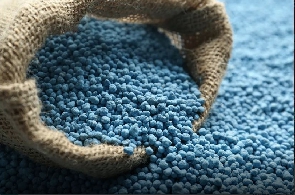Government has joined forces with OCP Group, a Moroccan company, to complete the front-end engineering design (FEED) for a US$1.3billion fertiliser complex at Takoradi, in a bid to diversify the economy and reduce reliance on oil and gas resources.
The project, expected to be operational within the next three years, aims to leverage Ghana’s natural gas reserves and boost the agricultural sector while reducing input costs for farmers.
Dr. Mohammed Amin Adam, Minister of State at the Ministry of Finance (MoF), made the announcement during the launch of the 2020 GHEITI Reports for the mining and oil/gas sectors. He said the fertiliser complex will play a crucial role in increasing fertiliser availability and lends credence to industrialisation of the agricultural sector.
Dr. Amin Adam emphasised the need to consider alternative sectors for sustainable development, citing recent declines in oil and gas production and potential negative impacts on the energy transition.
“In line with government’s strategy for long-term economic growth, we are focused on establishing linkages and diversifying the economy,” said Dr. Amin Adam. “This fertiliser complex is a significant step toward achieving those objectives, and it will contribute to the overall development of Ghana.”
The 2020 GHEITI Reports revealed that the country has made significant strides in its resource governance framework in recent years on the back of regulatory reforms, in part due to institution of the Fiscal Responsibility Act and Minerals Income Investment Fund Act.
As a result, the country’s gold mining sector surged from a total score of 56 out of 100 points in 2017 to 69 out of 100 points in 2020, according to the Resource Governance Index report released by the Natural Resource Governance Institute. The report also saw the revenue management sub-component increase from 37 percent in 2017 to 54 percent in 2020, indicating that government has made notable progress in managing mineral and economic rents.
The key findings of the oil and gas report showed that the sector contributed 3.7 percent to Ghana’s Gross Domestic Product (GDP) in 2020 and recorded a growth rate of -4.6 percent (at constant 2013 prices). In 2020, 66.91 MMbbls of crude oil were produced compared to 71.4 MMbbls in 2019, and the total petroleum receipts for 2020 were US$666.39million compared to US$937.58million in 2019. The total number of persons employed by large-scale mines in 2020 was 34,363 – of which 98.7 percent were Ghanaians.
The mining and quarrying sector’s share of Ghana’s GDP marginally reduced from 7.8 percent in 2019 to 7.6 percent in 2020, while the total volume of gold produced decreased from 4.577 million ounces in 2019 to 4.023 million ounces in 2020 – representing a downturn of 12 percent. Meanwhile, the volume of manganese produced tumbled from 5.383 million tonnes in 2019 to 2.358 million tonnes in 2020, representing a decrease of 56 percent.
The volume of bauxite produced increased from 1.116 million tonnes in 2019 to 1.162 million tonnes in 2020, recording a 4 percent year-on-year growth in its output. Finally, receipts from the export of minerals represented 48.4 percent of the country’s total merchandise export revenue in 2020, with crude oil and cocoa contributing 20.1 percent and 16.1 percent, respectively. Proceeds from mineral exports increased from US$6.678billion in 2019 to US$6.998 billion in 2020, translating into a 4.8 percent year-on-year expansion in mineral revenue.
The Multi-Stakeholder Group of the Ghana Extractive Industries Transparency Initiative (GHEITI), a tripartite body made up of government, industry and civil society, said the reports go beyond the mere reconciliation of payments and receipts to include contextual information: such as the summary description of the legal framework and fiscal regime; the sector’s contribution to the economy; production and export data; state participation in the extractive industries; revenue allocations; sustainability of revenues; and licence registers and licence allocation among several other requirements.
Business News of Wednesday, 7 June 2023
Source: thebftonline.com







![NPP Flagbearer, Dr. Mahamudu Bawumia [L] and NDC Flagbearer John Mahama NPP Flagbearer, Dr. Mahamudu Bawumia [L] and NDC Flagbearer John Mahama](https://cdn.ghanaweb.com/imagelib/pics/869/86902869.295.jpg)









